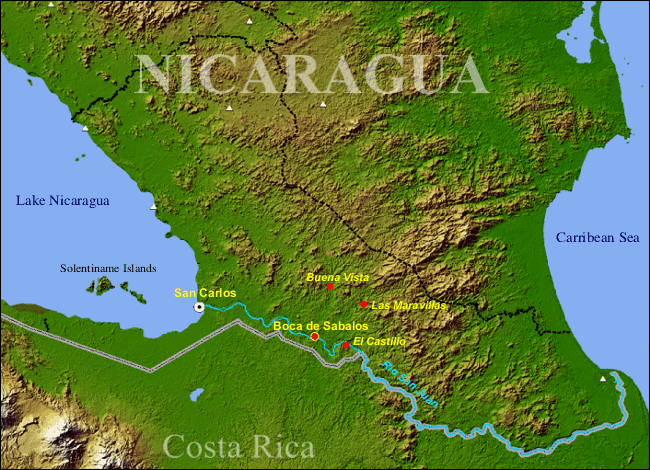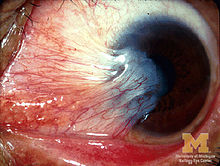 The Rio San Juan area of Nicaragua is such a poor area that health care opportunities are far flung or often unavailable. One of the reasons our church, along with the Santa Rosa Sunrise Rotary Club and other partners with San Juan Rio Relief, have returned for five years to run eye glass clinics is there is no optometric help in the area. In the past, folks from our church, St. Mark Lutheran, have hiked or ridden four-wheel drive vehicles into the jungle and farmlands of southeastern Nicaragua. The young people, in particular, have returned with stories of broken bridges, ankle-deep red mud and sketchy vehicles. We got it easy on our trip–we stepped into a boat and sailed to either El Castillo or Sabalos, short river journeys from where we stayed.
The Rio San Juan area of Nicaragua is such a poor area that health care opportunities are far flung or often unavailable. One of the reasons our church, along with the Santa Rosa Sunrise Rotary Club and other partners with San Juan Rio Relief, have returned for five years to run eye glass clinics is there is no optometric help in the area. In the past, folks from our church, St. Mark Lutheran, have hiked or ridden four-wheel drive vehicles into the jungle and farmlands of southeastern Nicaragua. The young people, in particular, have returned with stories of broken bridges, ankle-deep red mud and sketchy vehicles. We got it easy on our trip–we stepped into a boat and sailed to either El Castillo or Sabalos, short river journeys from where we stayed.
In El Castillo, we set up our clinic in the community center, a large room often used as a church that included moveable pews. The larger room with double front doors and jalouise windows running along the north and south sides, was where we registered our patients, tested for their dominant eye, used charts to get a distance assessment and eventually fitted those in need with glasses.
In a smaller, dark room in the back, we used a portable auto-refractor to measure their vision. We marked the numbers down on a card and the patients visited John Jones, the trip leader.
An experienced Rotarian who has participated in eyeglass clinics around the world, John would shine a light into their eyes to assess for two things: cataracts and the formation of pterigiums. Using Rafael or a Peace Corps worker as translator, John then explained what he had seen to the often nervous patient. He’d mark the card and send them into the main room where someone would fit the patient with glasses.
Sometimes the numbers from the auto-refractor, or John’s observation, indicated a far greater problem than the need for spectacles. Fortunately, we had an optometrist with us from Managua, Dolores Jarquin.
 Dolores studied for eleven years in Cuba and is an attorney as well as an optometrist in a Managuan clinic. She spoke gently, clearly and with tenderness to the patients who came to her. She also set aside several Bibles each day and when she had a patient, usually an elderly one, who needed some comfort she would give them a Nueva Testamento. At least once in the last five years, eye surgery has been done in this area. Dolores was screening for potential candidates, particularly for cataract surgery.
Dolores studied for eleven years in Cuba and is an attorney as well as an optometrist in a Managuan clinic. She spoke gently, clearly and with tenderness to the patients who came to her. She also set aside several Bibles each day and when she had a patient, usually an elderly one, who needed some comfort she would give them a Nueva Testamento. At least once in the last five years, eye surgery has been done in this area. Dolores was screening for potential candidates, particularly for cataract surgery.
I didn’t realize cataracts are usually caused by over-exposure to the sun–which is why they primarily are found in the elderly. Older people, particularly ones who work outside, have had their eyes exposed to the sun more than younger folks sitting in classrooms or offices. The closer they live to the equator, the more exposure people have to the sun. In poorer parts of the world, the chances they’ve worn sunglasses to block some of the glare–or have even known to do so–are minimal. Cataracts and their distant cousins pterigiums, were the most common chronic physical eye problems we saw in Nicaragua.
Pterigiums (also spelled pterygiums) are like cataracts in that their growth over the cornea blocks the ability of the eye to work properly. They take a while to develop and their growth can be slowed if precautions are taken one they’re detected. We handed out a lot of sunglasses, particularly to young people whose vision was otherwise fine, as preventative measures. They can develop in either eye, individually or at the same time, and can be painful. Many of the people we met, including me, were surprised to learn how important it is to shade your eyes properly. (In North America, surfers are more likely to develop pterigiums than the average person).
they’re detected. We handed out a lot of sunglasses, particularly to young people whose vision was otherwise fine, as preventative measures. They can develop in either eye, individually or at the same time, and can be painful. Many of the people we met, including me, were surprised to learn how important it is to shade your eyes properly. (In North America, surfers are more likely to develop pterigiums than the average person).
 Our San Juan Rio Relief liason/translator Rafael explained in an animated way that the farmers need to wear large floppy hats like his–not ball caps whose brim shaded their face but did not block sunlight coming from the side–which plays a role in the development of pterigiums (click on the link and read about it in Wikipedia). The rest of us put on our sun glasses and tugged our hats into place when we stepped foot outside.
Our San Juan Rio Relief liason/translator Rafael explained in an animated way that the farmers need to wear large floppy hats like his–not ball caps whose brim shaded their face but did not block sunlight coming from the side–which plays a role in the development of pterigiums (click on the link and read about it in Wikipedia). The rest of us put on our sun glasses and tugged our hats into place when we stepped foot outside.
Meanwhile, plans are afoot to add a small surgical clinic to the humble medical clinic in Sabalos, thus enabling more routine surgeries like cataract operations or emergency appendectomies to be done on-site, rather than having to take a bumpy two-hour ride up the road to San Carlos. It all takes money, of course.
For more information on what I was doing in Nicaragua, read my initial post on the subject here.




This was really interesting, Michelle. I had never heard of Pterigiums before. Nor had I realized that baseball caps wouldn’t protect as well from eye problems. The younger generation (and the old guys) need to know this. I’m passing the word along! Thanks.